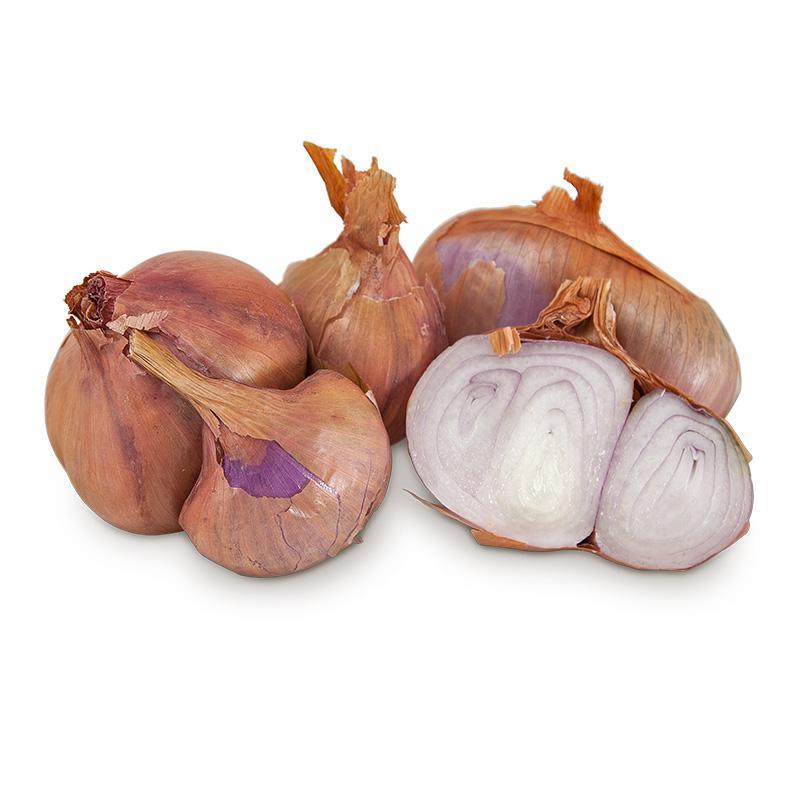Item Number: FP400
Organic French Red Shallots (lb)
Excellent Mild, Rich Onion Flavor
- French Red Shallots are an indispensable staple in French cuisine
- Mid-sized, and very tasty shallot
- Very tolerant and can be grown in acidic soil down to 5.0 pH, but prefers 6.0-6.8 pH
- Plant in fertile, well-drained soil
- Approximately 4-6 bulbs per lb., 3-4 cloves per head or bulb
- Smaller bulbs have been shown to produce less bulbs per clump, but larger bulbs. With larger bulbs, you will get more bulbs per clump but they will be smaller (article on growing Shallots).
French Red Shallots, with their excellent mild, rich onion flavor, are an indispensable staple in French cuisine. These mid-sized, very tasty shallots add depth and complexity to dishes, making them a favorite among chefs and home cooks alike. If you're interested in cultivating these flavorful bulbs in your own garden, here's everything you need to know about growing French Red Shallots.
Soil Requirements
French Red Shallots thrive in fertile, well-drained soil. While they are very tolerant and can be grown in acidic soil with a pH as low as 5.0, they prefer soil with a pH range of 6.0 to 6.8. Before planting, it's essential to prepare the soil by incorporating organic matter such as compost or well-rotted manure to improve fertility and drainage.
Planting Time
French Red Shallots are typically planted in the fall for a late spring or early summer harvest. Planting shallot bulbs in the fall allows them to establish roots before the onset of winter. However, they can also be planted in early spring as soon as the soil is workable.
To successfully grow shallots, it's crucial to pay attention to the pH levels of the soil. These shallots thrive in soil with a pH ranging from 6.0 to 6.8, ensuring optimal nutrient uptake and healthy growth. However, maintaining the correct pH levels is just one aspect of cultivating vibrant shallot plants. Nutrient deficiency can pose a challenge, affecting the overall health and productivity of the crop.
Therefore, it's essential to provide adequate nutrition through balanced fertilization, addressing any deficiencies that may arise. By carefully monitoring pH levels and addressing nutrient deficiencies, gardeners can ensure that their French Red Shallots flourish, providing a bountiful harvest of flavorful bulbs to complement a variety of fruits and vegetables in culinary creations.
Planting Depth and Spacing
Plant shallot bulbs with the pointed end facing upwards, at a depth of 1 to 2 inches in rows spaced 12 to 18 inches apart. Space the bulbs 6 to 8 inches apart within the rows to allow for proper bulb development.
Watering and Mulching
Keep the soil consistently moist but not waterlogged, especially during the early stages of growth. Mulching around the shallot plants with organic material such as straw or shredded leaves helps retain soil moisture, suppresses weed growth, and maintains a more stable soil temperature.
Fertilization
French Red Shallots benefit from regular fertilization to support healthy growth and bulb development. Apply a balanced fertilizer high in phosphorus (the middle number in the N-P-K ratio) at planting time and side-dress with additional fertilizer once the shallots begin actively growing.
Weed Control
Keep the area around the shallot plants free from weeds, as weeds can compete with shallots for nutrients, water, and sunlight. Regularly remove weeds by hand or use mulch to suppress weed growth.
Pest and Disease Management
French Red Shallots are relatively pest and disease resistant. However, they may occasionally be susceptible to pests such as onion thrips or diseases such as white rot. Practice crop rotation and maintain good garden hygiene to minimize the risk of pests and diseases.
Harvesting
French Red Shallots undergo a gradual plant growth process over a long period, making them an ideal spring plant. As they mature, the tops of the shallot plants gradually turn brown, signaling readiness for harvest. This extended growth period allows the shallots to develop their characteristic rich flavor and firm texture, perfect for enhancing a variety of culinary dishes.
French Red Shallots are ready for harvest when the tops begin to yellow and dry out, usually in late spring or early summer, approximately 90 to 120 days after planting. Carefully lift the shallot bulbs from the soil using a garden fork, taking care not to damage the bulbs. Allow the bulbs to cure in a warm, dry, well-ventilated area for 1 to 2 weeks to improve flavor and storage quality.
French Red Shallots, renowned for their exquisite flavor and versatility, are a quintessential ingredient in French cooking. Planted in the spring, these shallots undergo a gradual but steady growth process over a long period, culminating in a flavorful harvest. Their delicate yet robust taste enhances a myriad of dishes, from savory sauces to hearty stews.
Additionally, when paired with tender green beans, French Red Shallots impart a subtle sweetness and depth of flavor, elevating the simplest of dishes to gourmet status. With their unique culinary charm and enduring appeal, French Red Shallots remain a beloved staple in both professional kitchens and home cook's gardens alike.
Storage
Once cured, French Red Shallots can be stored in a cool, dry, well-ventilated location for several months. Store them in mesh bags or wooden crates to allow for air circulation and prevent molding or sprouting.
Propagation
French Red Shallots can be propagated by planting individual cloves or by dividing the bulbs into smaller sections before planting. Smaller bulbs may produce fewer bulbs per clump but tend to produce larger individual bulbs, whereas larger bulbs may result in more bulbs per clump but of smaller size.
Growing French Red Shallots is a rewarding endeavor that allows you to enjoy the rich, mild flavor of these versatile bulbs straight from your garden. By following these guidelines for soil preparation, planting, care, and harvest, you can cultivate a bountiful harvest of delicious shallots to enhance your culinary creations.
For more information, please enjoy our Resource Guide for planting and growing seed shallots as well as our latest shallot Blog posts.
** For more information, see our Garlic Resource Center and try out our Garlic Selector Tool to find the perfect garlic for your growing zone and tastes. Or check out all of our Garlic Learning Blogs where our staff have selected dozens of articles, videos, recipes and tips to help you learn how to successfully grow garlic bulbs.**



Check Your Zone Compatibility:
Compatible with your zone.
Growing Zone for

Our Guarantee To You
Since 1976, we've served our customers at every stage of growing. Please contact us at any time. We are happy to support and assist you.
Shipping Information
Shipping Information
We cannot delay ship garlic/shallots. They will be shipped as soon as they are in stock.
Cannot ship to the following states: HI, ID, PR, GU, VI
Shipping Weight: 1.1 lb
Dimensions: 5.0"L x 3.0"W x 3.0"H
Features
Features
- Bulb
- CCOF Certified Organic
- Container Compatible
- Easily Established
- Flavor Pick
- Good for Beginners
Characteristics
Characteristics
Planting & Care
Planting & Care
Useful Information
Useful Information
Guarantee
Guarantee
We guarantee the perishable items we sell to be in good, viable condition when we sell them. Perishable items include, but are not limited to, garlic bulbs, flower bulbs, seed potatoes, onion sets & transplants, potted or bare root trees, vegetable crowns, etc. If your perishable item arrives in substandard condition, take photographs and please contact us within 3 days of the purchase date (or delivery date) and we will provide you with a refund of the purchase price (excluding shipping costs), or a replacement. Accordingly, we urge you to open any boxes marked as ""Perishable"" immediately upon receiving them and inspect the shipment thoroughly (do not crack open heads of garlic, we do not accept claims on cracked garlic). Because some perishable items can deteriorate very quickly, we cannot accept any claims beyond the 3-day time frame as it becomes too difficult to determine if these items were delivered in substandard condition, or if they turned into such substandard condition because of having been improperly cared for or stored once delivered.
Share



Came as expected
These showed up looking great. They were very difficult to separate though.
Everything I have received from grow organic has been high quality and has produced beautifully. Very happy with these shallots.
wonderful quality
Shallots look beautiful!! I haven’t got them in the ground yet-the garlic also looks great!








